Highlights of the Price Situation in Samar Province November 2023-2024
Reference No.: 202411-0860-13
Release Date: 22 December 2024
Highlights of the Price Situation in Samar Province
November 2023-2024
(2018=100)
Samar's inflation rate increased from 1.4 percent in October 2024 to 2.0 percent in November 2024. This marks a rise of 0.6 percentage points compared to the previous month, but a decrease of 2.6 percentage points compared to November 2023. Year-to-date, the province's inflation rate is 3.6 percent, which is 0.3 percentage points higher than the regional average (see Table 1).
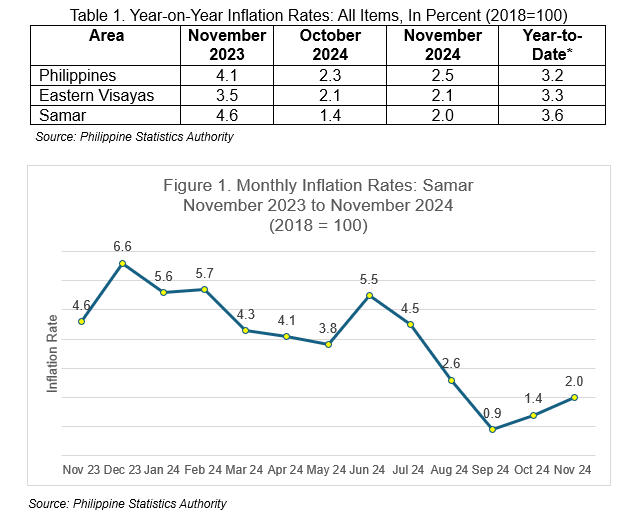
The higher inflation was primarily driven by increases in price indices for: 1) Food and Non-Alcoholic Beverages, which rose from 0.5 in October to 2.1 percent in November; 2) Transport, which improved from negative 1.6 to negative 1.3 percent; and 3) Housing, Water, Electricity, Gas, and Other Fuels, which increased from 4.0 to 4.7 percent (see Figure 2).

![]()
Food Inflation
The inflation rate for Food rose from 0.3 percent in the previous month to 2.1 percent in November. Five food commodities exhibited an upward trend in November: 1) Fish and Other Seafood (6.3%); 2) Vegetables, Tubers, Plantains, Cooking Bananas, and Pulses (5.4%); 3) Sugar, Confectionery, and Desserts (-5.9%); 4) Meat and Other Parts of Slaughtered Land Animals (-0.7%); and 5) Oils and fats (-1.8%).
On the other hand, Fruits and Nuts (-1.6%), Milk, Other Dairy Products, and Eggs (2.6%), Cereals and Cereal Products (0.9%), Ready-made Food and Other Food Products n.e.c. (4.0%) recorded a downward trend.
The major contributors to food inflation for the month are as follows: 1) Fish and other Seafood, contributing 55.6 percent; and 2) Vegetables, Tubers, Plantains, Cooking Bananas, and Pulses, contributing 41.6 percent.
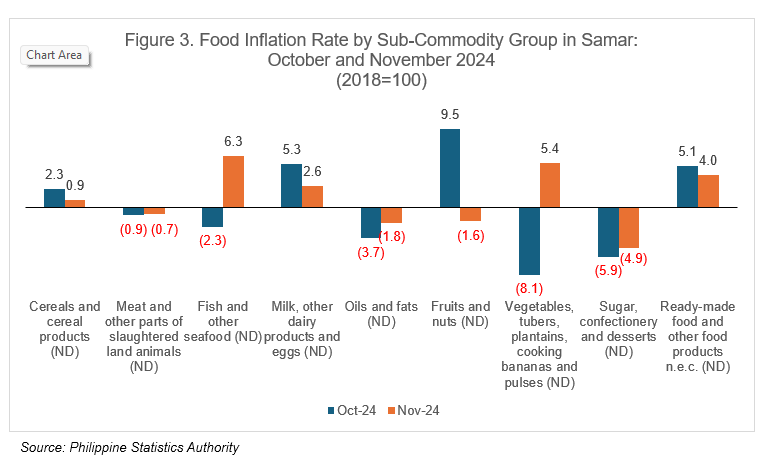
Consumer Price Index
In November 2024, the Consumer Price Index (CPI) was recorded at 130.5. This indicates that the overall basket of items has increased by 30.5 percent since 2018, the base period. Additionally, this marks a rise of 2.6 percentage points compared to the same month last year. (Figure 4)
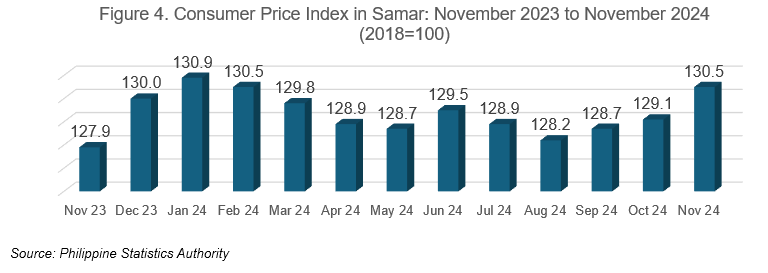
Purchasing Power of the Peso (PPP) remains at PhP 0.77
Samar’s purchasing power of the peso remains at 0.77 centavo indicating that one peso from 2018 is equivalent to 77 centavos in November 2024. (Figure 5)
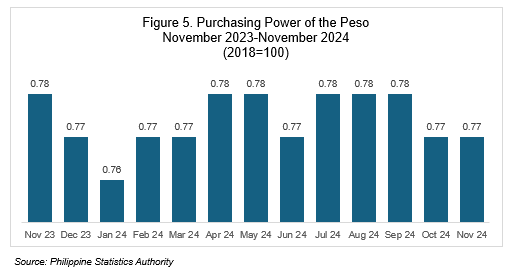
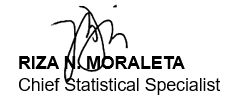
ANNEXES
Table A. Year-on-Year Inflation Rate
Samar: January 2019 to November 2024
(in Percent, 2018 – Base Year)
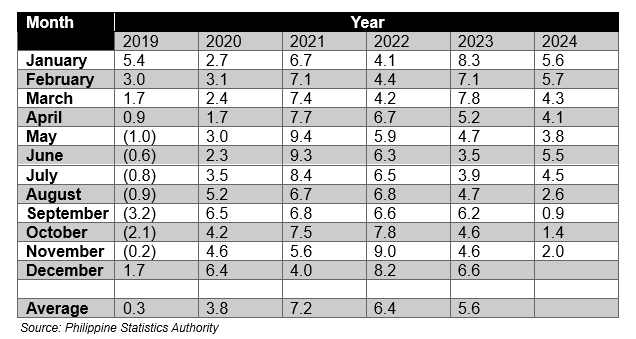
Table B. Consumer Price Index and Inflation Rate for All Income
Households in Samar, By Commodity
October 2024 – November 2024
(2018=100)
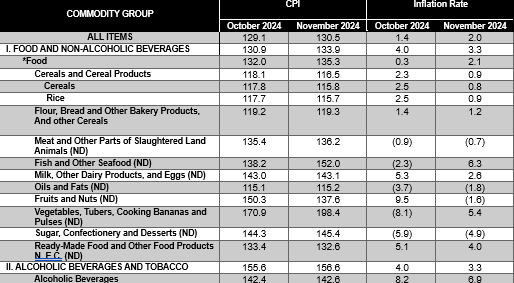
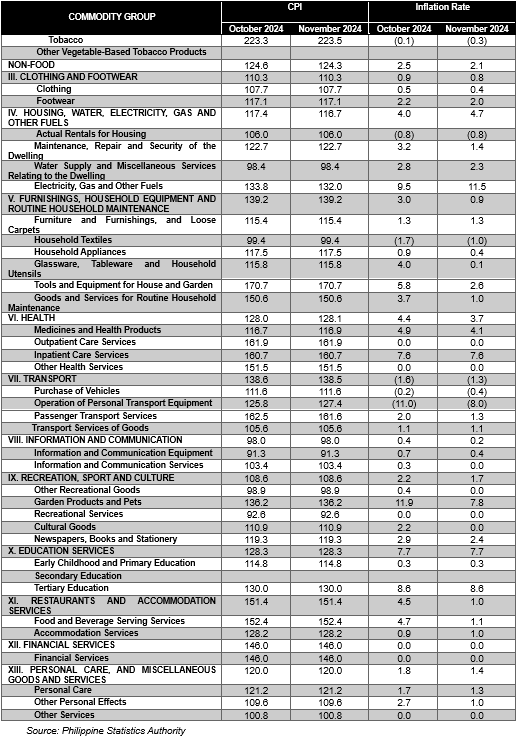
TECHNICAL NOTES
The current CPI series is 2018-based. The rebasing to 2018 is the 12th base period and 11th rebasing for CPI. The five steps involved in the rebasing/computing of CPI are as follows: (1) identification of the base year (2) determination of the market basket (3) determination of household consumption patterns/weights (4) monitoring of prices of items in the basket and (5) computation of CPI.
The 2018-based CPI series uses the same method of computation as the 2012-based CPI series, which is chained Laspeyres formula.
BASE YEAR - is a period at which the index number is set to 100. It is the reference point of the index number series. The CPI is rebased from 2012 to 2018.
CONSUMER PRICE INDEX (CPI) - is an indicator of the change in the average prices of a fixed basket of goods and services commonly purchased by households relative to a base year.
DEFLATION - is the decline in prices for goods and services that happens when the inflation rate dips below zero percent.
INFLATION RATE (IR) - is the annual rate of change or the year-on-year changes in CPI. It indicates how fast or how slow price changes over two time periods (year-on-year). Contrary to common knowledge, low inflation does not necessarily connote that prices of commodities are falling. It means that prices continue to increase but at a slower rate.
MARKET BASKET - refers to a sample of goods and services commonly purchased by the households. The market basket for CPI was updated using the results of the 2021 Survey of Key Informants (SKI). The commodities included in the 2018-based CPI market basket were the modal commodities which were considered as the most commonly purchased/availed commodities by the households. The commodities in the 2018-based CPI market basket were grouped/classified according to the 2020 Philippine Classification of Individual Consumption According to Purpose (PCOICOP).
MONITORING OF PRICES - involves establishing baseline information for the prices of the items in the base year and monitoring the prices of the items on a regular basis. Data collection for the CPI is done by the provincial office twice a month, except for petroleum products which are monitored on a weekly basis, every Friday. First collection phase is done during the first five days of the month while the second phase is on the 15th to 17th day of the month.
PURCHASING POWER OF PESO (PPP) - gives an indication of the real value of peso (how much it is worth) in a given period relative to its value in the base period. It is computed as the reciprocal of CPI multiplied by 100.
RETAIL PRICE - refers to the actual price at which retailers sell a commodity on spot or earliest delivery, usually in small quantities for consumption and not for resale. It is confined to transactions on cash basis in the free market and excludes underground prices and prices of commodities that are on sale as in summer sales, anniversary sales, Christmas sales, etc.
WEIGHTS - is a value attached to a commodity or group of commodities to indicate the relative importance of that commodity or group of commodities in the market basket. The weights for the 2018-based CPI were derived from the expenditure data of the 2018 Family Income and Expenditure Survey (FIES). The weight for each commodity/group of commodities is the proportion of the expenditure commodity/group of commodities to the total national expenditure. The sum of the weights of the commodity groups at the national level is equal to 100.

